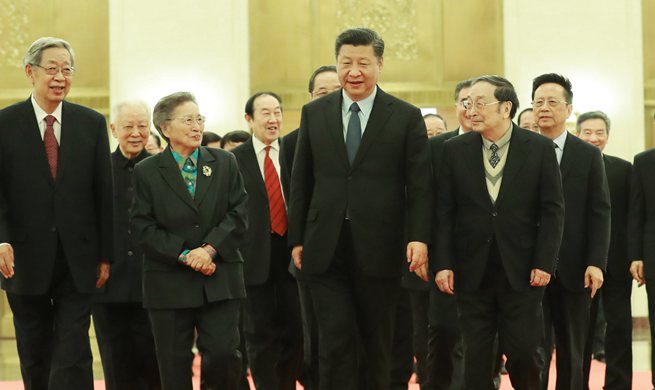NEW YORK, Feb. 6 (Xinhua) -- U.S. stocks rose in volatile trading on Tuesday, as major indices tried to recover from the biggest one-day declines for the Dow and the S&P 500 in more than six years.
At midday, the Dow Jones Industrial Average added 75.17 points, or 0.31 percent, to 24,420.92. The S&P 500 increased 2.91 points, or 0.11 percent, to 2,650.65. The Nasdaq Composite Index was up 42.47 points, or 0.61 percent, to 7,011.59.
Tuesday's market is marked by a return of volatility to the equities market that have been absent for quite some time.
The Dow traded in a near-1,000 point range in the morning session. It fell more than 500 points at the open, rebounded shortly afterwards to a 1 percent gain and then dipped 0.74 percent before it went back to green territory.
Both S&P 500 and the Nasdaq followed the suit, both made more than 1 percent gain 10 minutes after the opening lower, and then swung up and down for the rest of the morning.
U.S. stocks plunged Monday, extending a steep sell-off from Friday, amid increasing concerns of rising bond yields and higher inflation reinforced by a stronger-than-expected jobs report.
The Dow Jones Industrial Average plummet nearly 1,600 points briefly in late trading, marking the worst intraday fall in market history.
The index settled 1,175.21 points, or 4.60 percent lower while the S&P 500 slumped 4.10 percent on Monday, both erasing 2018's gains.
On Friday, the Dow plunged 665.75 points, while the S&P 500 and the Nasdaq dropped 2.12 percent and 1.96 percent respectively.
The U.S. Treasury Secretary Steven Mnuchin said on Tuesday at a hearing of the House Financial Services Committee that the markets are "functioning very well," and the drop didn't pose any financial stability concerns.
He said the Trump administration's policies are very positive for long-term economic growth and that the administration still takes credit for stocks market rise as it went up for more than 30 percent since the presidential election day in 2016.
The Dow closed at 18,332.74 on Nov. 8, the election day, in 2016. The index has since rallied more than 8,000 points in a little more than a year's time, reaching its peak on Jan. 26 this year at 26,616.71.
U.S. President's Donald Trump has repeatedly touted the bull market since his election as proof of his capability of managing the country's economy. He tweeted multiple times in 2017 when the Dow broke thousand-point milestones.
Market analysts attributed first half of 2017's bull market to Trump's election victory and his promises of a series of economic stimulus plan including relaxing regulations, cutting tax, and spending more on infrastructure. Wall Street called the period the "Trump Rally."
While the top equities stories for second half of 2017 were stronger-than-expected corporate earnings, U.S. economic growth and global economy recovery, Trump continued to take credit for the market on the way up.
He did "played Santa" for the market just around the Christmas last year, when he signed the GOP tax bill in law on Friday, capping off a months-long effort to pass the legislation through the Republican-controlled Congress on Dec. 22.
The equities market has since entered into an even crazier rally, until last week, when fears that the market valuations were too high, the Fed would speed up interest rate hikes that would hurt corporate profitability, and that the bond yields were raising close to a warning level served as the catalysts for market sell-off.
As market strategists have pointed out, Monday's slide was not caused by anything fundamental. Instead, the investors' move to lock in profits, possibly some computer-programed trading, combined with concerns about interest rates have sent the equities into correction territory.
On Tuesday, the Cboe Volatility Index, Wall Street's fear gauge, rose to as high as 50.30 on Tuesday morning, the highest level since August 2015, before dropping back down to 37.51. But the level was still remarkably high compared to just a week ago.
Among such volatility, equities strategists continued to say there is no reason to panic, calling the week-long selloff overdue.
"U.S. equities have performed remarkably well since March 2009. While dramatic in the short term, today's price action is a healthy correction which is overdue," said Brendan Ahern, chief investment officer of the U.S. Krane Funds Advisors.
He told Xinhua that investors are rebalancing their portfolios from U.S. equities to more reasonably valued equity markets like China, Europe and emerging markets.
Mark Haefele, global chief investment officer of wealth management at UBS, said in a note that the bank does not believe that now is a time to reduce exposure to stocks. He added that as long as the recent rise in bond yields moderates, the bank is confident that market conditions will remain orderly.

















